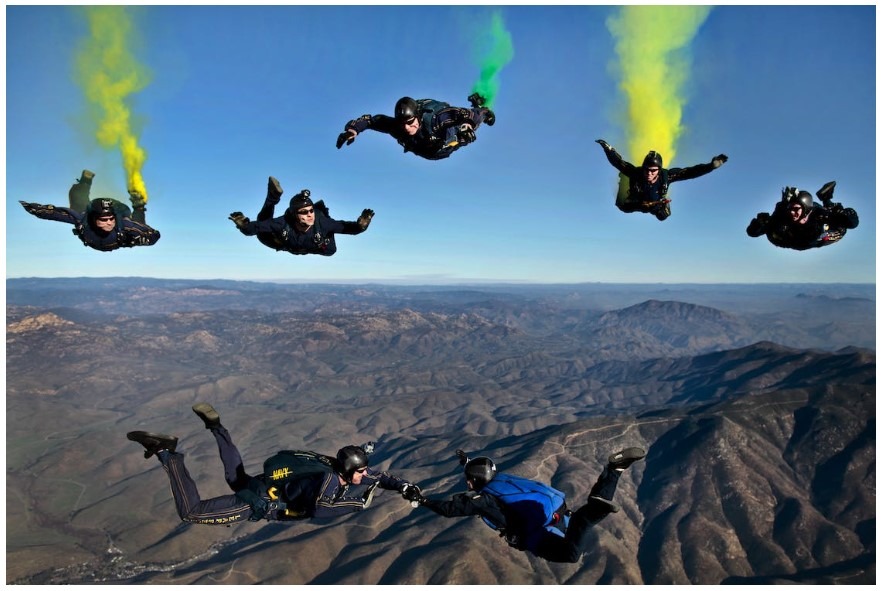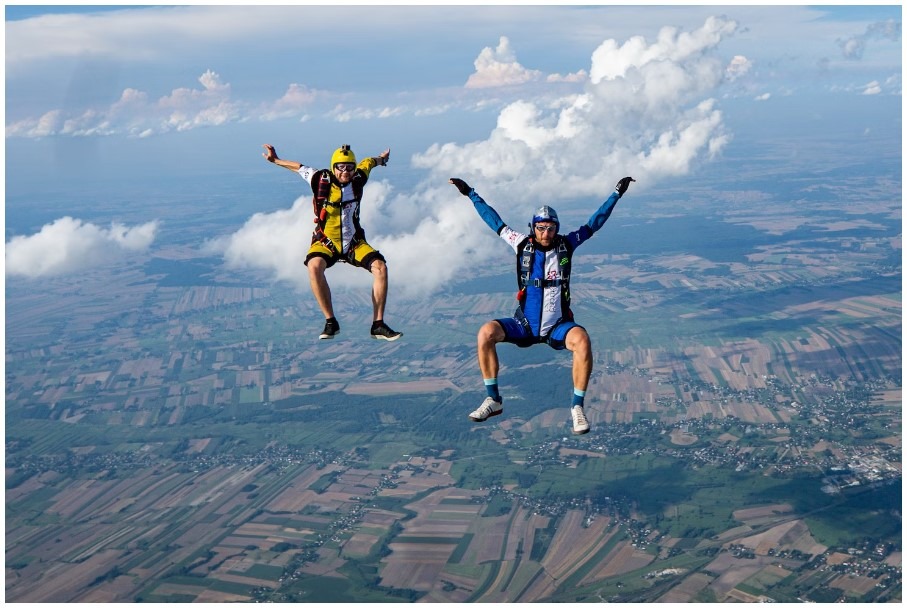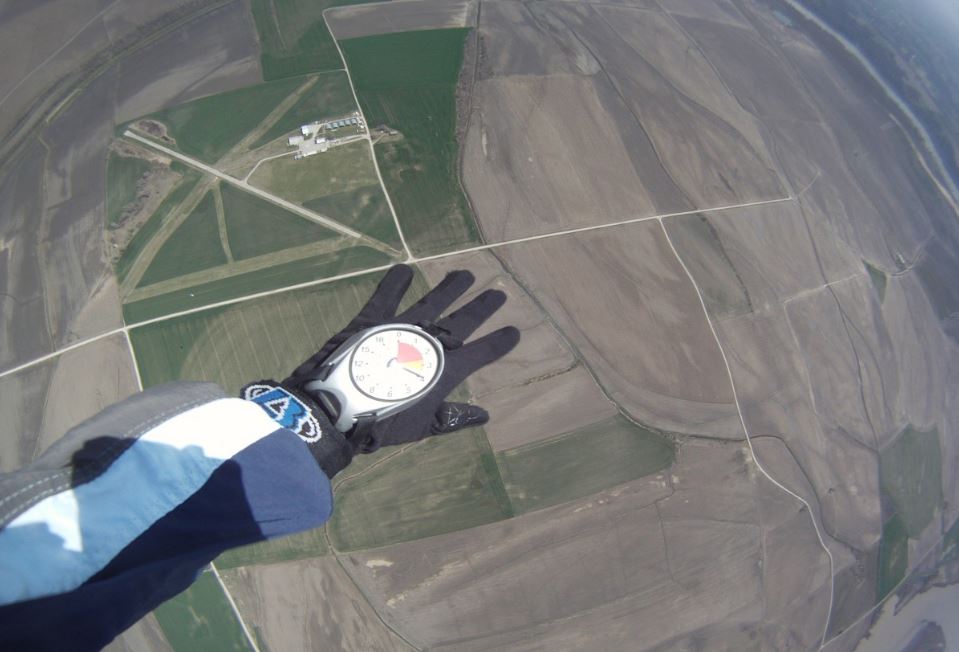The development of body flight can be seen in freeflight. Freeflying increases the range of options to include all conceivable orientations, not content to be limited to a belly to ground orientation. This includes, but is not limited to, facing the earth with your back, facing the earth with your feet or your head, and facing the sky with your body angled like a wing. These body postures cover a broad spectrum of velocities and potential energies. They encourage traveling both laterally and vertically in the multidimensional sky rather than just dropping straight down to the ground. Coaching is strongly advised in order to navigate your body in these advanced orientations safely, effectively, and consciously. The competitive disciplines of artistic freeflying, freestyle, vertical formation skydiving, and mixed formation skydiving all fall under the umbrella of freeflying.
History
In contrast to the conventional “belly-to-earth” orientation, the skydiving discipline known as “freeflying” first emerged in the late 1980s. It involves freefalling in a variety of vertical orientations. Olav Zipser is credited with developing the discipline when he started experimenting with unconventional bodyflight techniques. In 1992, Zipser and Mike Vail established the FreeFly Clowns as a two-person competitive team. In 1994, Stefania Martinengo, Charles Bryan, and Omar Alhegelan—the first-ever FAI Freestyle World Cup and World Champion—joined the team. The First School of Modern SkyFlying, the first institution to teach freeflying, was founded by the FreeFly Clowns.
In 1996, the SSI Pro Tour incorporated freeflying as a three-person competitive discipline during the second broadcast event (with Skysurfing), as part of ESPN’s Destination Extreme series. This brought freeflying to the public’s attention. The FreeFly Clowns (Olav Zipser, Charles Bryan, and Omar Alhegelan), along with other teams like the Flyboyz (Eli Thompson, Mike Ortiz, Knut Krecker, Fritz Pfnür), Team AirTime (Tony Urugallo, Jim O’Reilly, Peter Raymond, Brian Germain), and many other freeflying pioneers, were watched by 150 countries as they won first place in all four international competitions.
In Olav Zipser’s Space Games, a “space ball” was utilized as a research and measurement tool to offer a consistent speed and direction from which athletes could be trained, evaluated, competed against one another, and assessed. FreeFlying was advanced in The Space Games from 1998.
In 2000, FreeFly was recognized as a skydiving discipline by the International Parachute Commission (IPC), and the first official FreeFly National & international Championships were held globally thanks to the efforts of Arizona Freeflight llc (Omar Alhegelan & Kama Mountz), who ran test competitions and wrote and submitted the rules for future competitions.
Different Positions in Freeflying
A freeflier must first master all of the skydiving positions, including the box position (traditional skydiving position, with the belly to the ground), back flying (with the back to the ground), head-up flying, head-down flying, and side flying, in order to fully comprehend the aerodynamic power of his or her body in freefall. These positions are not maintained throughout the jump. Continuous changes in position, speed, and orientation with both vertical and horizontal axes can and often do occur during freeflying. This can be done by continuously flowing skydives in which all positions are explored, or it can be done through more static skydives in which participants focus on forming a big formation while in one of these freefly positions.
Back flying
Being able to fly on one’s back steadily and with control is known as back flying. This ability is essential to ensuring that the flyer maintains control and doesn’t put other skydivers or herself in danger when flipping out of some of the more complex positions.
Sit flying
The reason why sit flying is so named is because it resembles the position taken when seated in a chair. When flying a sit, the feet should be pointed in the direction of the relative wind, and the knees, hips, and shoulders should all be bent 90 degrees. The flyer turns the wind in the opposite direction from where the jumper wants to travel to move about. The flyer is subsequently propelled in the intended direction by Newtonian mechanics. Alterations to the fall rate, such as a faster or slower descent, are also possible.
Head down
As a result of having less cross-sectional area exposed to the air as they fall, head-down fallers experience substantially faster fall rates. When flying head down, the average speed is about 260 km/h (160 mph). The risk associated with skydiving increases since every movement can make the skydiver unsteady or disoriented due to the increased speed.
Freeflying Safety
Freeflying is thrilling, innovative, and a lot of fun. Safety should always be a concern. Maintaining a safe flying environment enables you to enjoy yourself more. The level of experience of individuals you travel with affects how securely you can fly. As long as the size of the flying group does not exceed the proficiency of those individuals flying together, the fundamentals of freeflight can be performed safely. The greatest way to practice freeflying is using 2-ways.
Freeflying involves a variety of flying positions that correspond to a variety of speeds between 90 and 300 miles per hour. A methodical development leads to safe freefly learning. Prior to going on to quicker flying positions, it is best to have a solid understanding of how to fly your body in slower flying positions. Awareness and reactions are improved by learning to control speed, direction, and proximity at lower speeds. These techniques guarantee everyone’s safety in the sky.
Smaller groups are the safest method to fly, as was previously mentioned. The most secure way to experience flight with someone else is one-on-one. It enables flyers to stay in constant visual contact with one another. As knowledge and experience expand, taking off with extra passengers can be enjoyable and safe. This depends on how well everyone prepared their dive and how skilled the flyers are. For breakoff, there are certain safety regulations. Speed is a key element once more. Freefly leaps have somewhat higher breakoff heights (4000 ft) because to their higher velocity.
In order to prevent abrupt changes in speed, it is also crucial to smoothly transition to a track. Follow and inspect the air quality. To ensure clean air, it is highly advised to do a slow barrel roll before to deployment. All participants will be safe and have fun if they abide by the straightforward guidelines of small groups, planning, awareness, and breakoffs.
Freefly Safety Equipment
Container: Every freeflyer needs a tightly fitting container that prevents the exposure of risers and pins. Closure is required due to changing body postures and increased airspeeds.
Altimeter: Freeflying requires the use of two altimeters—visual and aural. When dealing with the faster speeds of freefly, altitude awareness becomes a new significance.
Clothing: It’s crucial to wear clothing that won’t impede mobility or hide any handles.Helmet: It is advised to wear a hard shell helmet.
Cypres: To anyone who can afford it, Cypres is advised. Collisions have a chance of happening. Being ready is therefore preferable.
Conclusion
Freeflying is quickly gaining popularity among skydivers despite the fact that it is becoming more difficult and dangerous. This expanding popularity is demonstrated by the haste with which manufacturers of skydiving gear are altering their equipment designs to accommodate the unique requirements of freefliers. Freeflying is a relatively recent and intense kind of skydiving, although it is quickly gaining popularity in competitions and world records.



